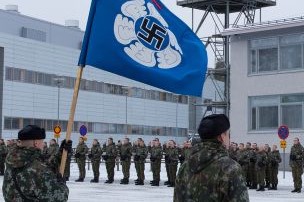Finnish Air Force Command drops swastika logo as insignia
The swastika still remains in some Air Force unit flags and decorations. Von Rosen, an upper-class explorer and ethnographer, was brother-in-law to Nazi leader Hermann Goering, who was a decorated World War I pilot, but the Swede had adopted and used the blue swastika symbol much earlier than the Nazis did.

- Country:
- Finland
Finland's Air Force Command has discreetly dropped its swastika logo as unit emblem — after a century — and replaced it with a neutral insignia featuring a golden eagle. The change — to avoid false and uncomfortable associations with Nazi Germany's notorious logo — took place in January 2017 but wasn't announced publicly by the military of the Nordic nation at the time.
Teivo Teivainen, professor of world politics at the Unversity of Helsinki who is currently doing research on the use of swastikas in Finland in the 1920s and 1930s, noted the issue in a Twitter post this week that brought it to public attention. Brig. Gen. Jari Mikkonen at Air Force Command Finland acknowledged Thursday to The Associated Press that the historical swastika emblem had created confusion over the years among international colleagues.
“Undeniably, we've had to explain from time to time the history of the (Finnish Air Force) swastika that dates back to 1918,” Mikkonen said. “It caused misunderstandings with our foreign partners, so continuing to use it was considered inappropriate and unnecessary.” The swastika is an ancient symbol and a religious icon in many cultures dating back thousands of years, but many still associate it with Nazi Germany's notorious swastika flag adopted by Adolf Hitler and his Nazi Party in the early 1920s. The Finnish Air Command swastika emblem traces its roots back to March 1918 when the Finnish Air Force was created only a few months after Finland had declared its independence on December 6, 1917.
Swedish Count Eric von Rosen donated to Sweden's new independent neighbor the first plane of its air force, a Thulin Typ D reconnaissance plane, that had a blue swastika — his personal good luck charm — painted on its wings. The Finnish Air Force soon after adopted the symbol — a blue swastika on a white background — and used it as the national insignia on all its planes from 1918 until 1945. The swastika still remains in some Air Force unit flags and decorations.
Von Rosen, an upper-class explorer and ethnographer, was brother-in-law to Nazi leader Hermann Goering, who was a decorated World War I pilot, but the Swede had adopted and used the blue swastika symbol much earlier than the Nazis did. The Air Force stressed the symbol has no links to Nazi Germany though Finland later entered into a reluctant alliance with the Third Reich during World War II.
“The Air Force is proud of its glorious traditions,” Brig. Gen. Jari Niskanen told the AP. “We're not ashamed of the swastika on our decorations and unit flag."
(This story has not been edited by Devdiscourse staff and is auto-generated from a syndicated feed.)










